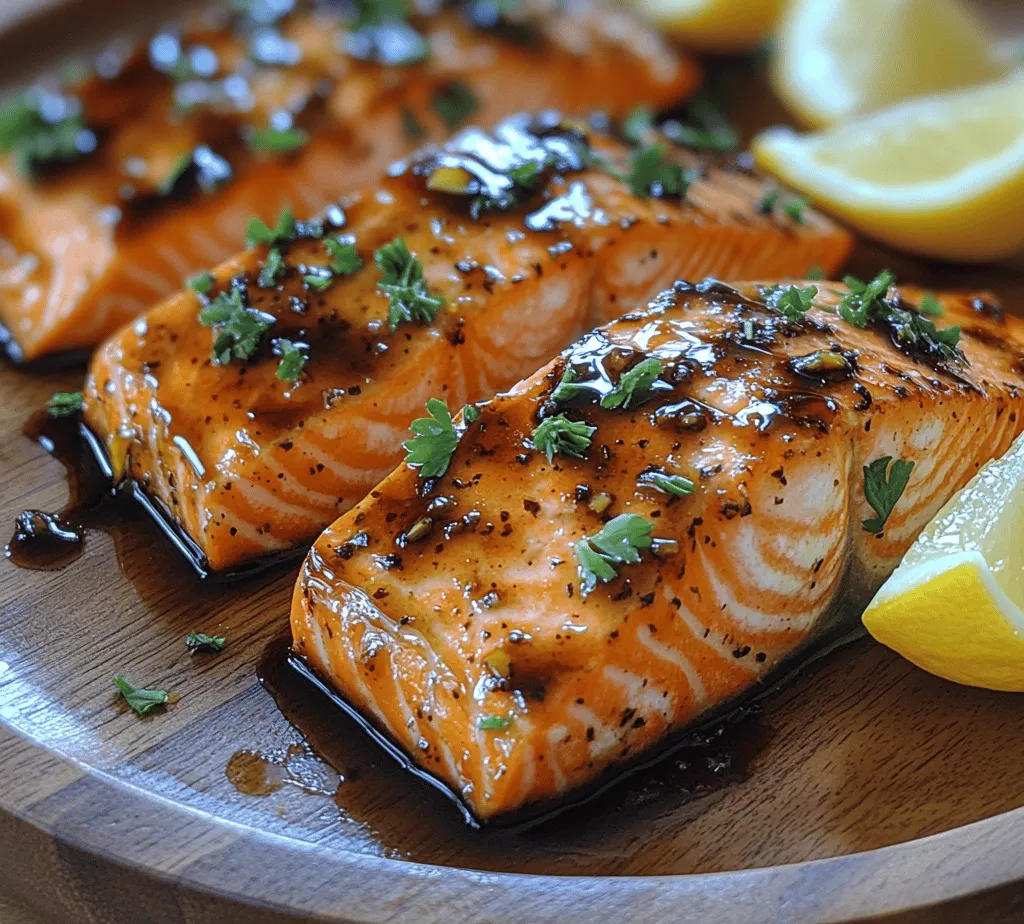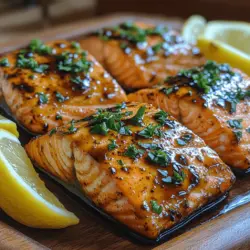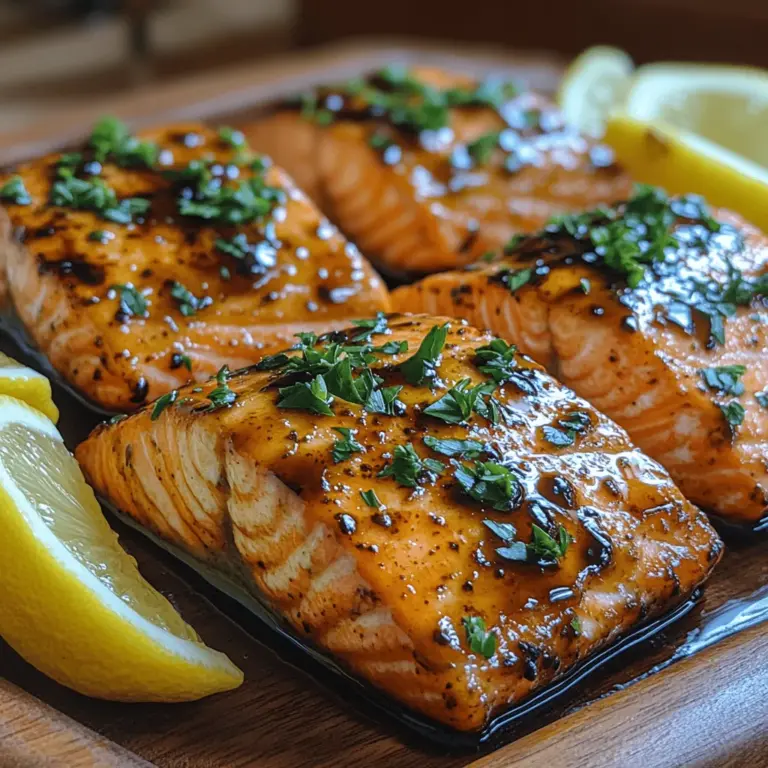Introduction
Salmon has surged in popularity over the past few decades, thanks to its rich flavor, versatility, and numerous health benefits. As a fatty fish, it’s packed with omega-3 fatty acids, which are known to promote heart health, reduce inflammation, and support brain function. Additionally, salmon is an excellent source of high-quality protein and essential vitamins and minerals, making it a staple in many health-conscious diets.
One of the most delightful ways to enjoy salmon is by pairing it with a balsamic glaze, which adds a sweet and tangy twist that elevates the fish’s natural flavors. Balsamic glaze is made by reducing balsamic vinegar, resulting in a thick, syrupy consistency that brings depth and complexity to dishes. The combination of the rich, savory salmon and the sweet-tart glaze creates a mouthwatering experience that is hard to resist.
In this article, we will provide a detailed recipe for Quick Balsamic Glazed Salmon, along with cooking tips and nutritional insights. This recipe is not only quick and easy to prepare, but it also brings the flavors of Italy right to your kitchen, making it perfect for busy weeknights or special occasions. Let’s dive into the ingredients that make this dish so special.
Understanding the Ingredients
Salmon Fillets
The star of our dish is undoubtedly the salmon fillets. When selecting salmon, look for fresh, wild-caught varieties if possible, as they typically have a more robust flavor and a firmer texture compared to farmed salmon. Nutritionally, salmon is a powerhouse; just a 3-ounce serving contains around 22 grams of protein, high levels of omega-3 fatty acids, and essential vitamins such as B12 and D. These nutrients contribute to overall health, making salmon an excellent choice for a balanced diet.
Balsamic Vinegar
Balsamic vinegar comes in various types, with the most common being traditional balsamic vinegar from Modena and commercial-grade balsamic vinegar. Traditional balsamic vinegar is made from freshly crushed grape must and aged for several years, resulting in a complex flavor profile that is sweet, tangy, and slightly syrupy. Commercial balsamic vinegar is often less expensive and typically includes additives to achieve a similar flavor, but it may lack the depth found in traditional varieties. For this recipe, opt for high-quality balsamic vinegar, as it significantly impacts the final taste of the glaze.
Honey or Maple Syrup
To balance the acidity of the balsamic vinegar, we will incorporate a natural sweetener such as honey or maple syrup. Both options provide a hint of sweetness without overwhelming the dish. Honey is rich in antioxidants and has been linked to various health benefits, including improved heart health and wound healing. Maple syrup, on the other hand, contains essential minerals like manganese and zinc, making it a great alternative for those who prefer a plant-based option. Choose whichever sweetener aligns with your dietary preferences.
Garlic
Garlic is a powerful ingredient that adds aromatic flavors to the glaze. Beyond its culinary use, garlic offers numerous health benefits, including improving heart health and boosting the immune system. Freshly minced garlic releases essential oils that enhance the overall flavor profile of the dish, creating a delicious balance with the other ingredients.
Dijon Mustard
For an extra kick, we will include Dijon mustard in our balsamic glaze. This ingredient brings a tangy and slightly spicy flavor, enhancing the overall complexity of the dish. Mustard is also known for its health benefits, including aiding digestion and providing anti-inflammatory properties. Its addition will help to elevate the sauce, making each bite of salmon even more flavorful.
Olive Oil
Olive oil is a staple in Mediterranean cuisine and plays a vital role in this recipe. Not only does it help to create a silky texture in the glaze, but it also provides healthy fats that are beneficial for heart health. Extra virgin olive oil is the best choice, as it contains antioxidants and has anti-inflammatory properties. It’s important to choose a high-quality oil, as the flavor will significantly affect the final dish.
Fresh Herbs
To finish off our Quick Balsamic Glazed Salmon, we’ll incorporate fresh herbs, which enhance both the flavor and presentation of the dish. Herbs like parsley, basil, or dill can add a burst of freshness and color, making the dish visually appealing and even more enjoyable. Fresh herbs are also packed with vitamins and minerals, providing additional health benefits.
Optional Ingredients
While the ingredients mentioned above form the base of our recipe, there are several optional ingredients you can consider adding to personalize your dish further. For example, red pepper flakes can introduce a touch of heat, while a splash of soy sauce can add umami depth. Feel free to experiment with different spices and herbs to create a flavor profile that suits your taste.
Preparing the Marinade
To begin, we will prepare the marinade that will serve as the foundation for our balsamic glaze. Here’s a step-by-step guide to ensure you achieve the perfect balance of flavors.
1. Gather Your Ingredients: Start by assembling all the ingredients needed for the marinade: balsamic vinegar, honey or maple syrup, minced garlic, Dijon mustard, and olive oil.
2. Combine the Ingredients: In a medium-sized bowl, combine 1/2 cup of balsamic vinegar, 2 tablespoons of honey or maple syrup, 2 cloves of minced garlic, and 1 tablespoon of Dijon mustard. Whisk these ingredients together until they are well blended.
3. Slowly Add Olive Oil: While whisking continuously, slowly drizzle in 3 tablespoons of extra virgin olive oil. This emulsification process will help to create a smooth and cohesive marinade that clings beautifully to the salmon.
4. Taste and Adjust: After whisking, taste the marinade and adjust the flavors as needed. If you prefer a sweeter glaze, add a bit more honey or maple syrup. For a tangier flavor, consider increasing the amount of Dijon mustard or balsamic vinegar.
5. Marinating the Salmon: Once your marinade is ready, place the salmon fillets in a shallow dish or a resealable plastic bag. Pour the marinade over the fillets, ensuring they are evenly coated. For maximum flavor, let the salmon marinate for at least 30 minutes, or up to 2 hours if time allows. The longer you marinate the salmon, the more flavorful it will become, as the marinade penetrates the fish and enhances its natural taste.
6. Considerations for Marinating Time: The marinating time impacts not only the flavor but also the texture of the fish. A shorter marinating time (around 30 minutes) will impart a light flavor, while a longer marinating time (up to 2 hours) will create a more pronounced taste. However, avoid marinating salmon for too long, as the acidity in the balsamic vinegar can begin to break down the fish’s texture, resulting in a mushy finish.
By following these steps, you will create a flavorful marinade that perfectly complements the salmon. The combination of sweet, tangy, and savory notes will come together beautifully, resulting in a dish that is not only delicious but also visually stunning when plated.
In the next part of our article, we will move on to the cooking instructions, where I will guide you through the process of cooking the marinated salmon to perfection. Stay tuned for the exciting conclusion of this Quick Balsamic Glazed Salmon recipe!

Cooking the Salmon
Cooking salmon might seem daunting at first, but with the right techniques, you can create a mouthwatering dish that’s both quick and easy. The first step in preparing your Quick Balsamic Glazed Salmon is preheating the oven. This is crucial because cooking fish at the correct temperature helps achieve a flaky, tender texture without drying it out. For this recipe, preheat your oven to 400°F (200°C). This temperature ensures the salmon cooks evenly and allows the glaze to caramelize beautifully without burning.
Detailed Guide to Baking the Salmon
Once your oven is preheated, it’s time to get the salmon ready for baking. Start by lining a baking sheet with parchment paper. This not only facilitates easier cleanup but also helps the salmon cook more evenly. The parchment creates a non-stick surface, which is especially beneficial when working with the balsamic glaze that can become sticky as it cooks.
Place the salmon fillets on the parchment-lined baking sheet, ensuring they are arranged with some space between each piece. This spacing allows for optimal heat distribution, ensuring that every fillet cooks perfectly without steaming each other.
Optional Broiling Step: Enhancing the Glaze and Appearance
After baking the salmon for about 12-15 minutes, you might want to consider an optional broiling step. Broiling can enhance the glaze’s flavor and appearance by creating a slightly crispy texture on top. To do this, switch your oven setting to broil. Keep a close eye on the salmon during this step, typically no more than 2-3 minutes, to prevent burning. The high heat from the broiler will caramelize the balsamic glaze, adding a rich depth of flavor and an appetizing color.
Tips for Monitoring the Broiler to Avoid Burning
When broiling, it’s essential to keep the oven door slightly ajar and watch the salmon closely. The broiler can char food quickly, so do not leave the kitchen during this process. A good tip is to check the salmon every minute. You’ll know it’s ready when the glaze is bubbling and the top of the salmon is slightly browned. Remove the salmon from the oven and let it rest for a couple of minutes before serving.
Serving Suggestions
Presentation plays a vital role in a meal, and there are several ways you can make your Quick Balsamic Glazed Salmon visually appealing. Start by transferring the cooked salmon to a serving platter. For added color and flavor contrast, garnish with fresh lemon wedges and a sprinkle of chopped parsley. The bright yellow of the lemon and vibrant green of the parsley not only elevate the visual appeal but also enhance the dish’s flavor profile.
Recommended Side Dishes to Complement the Salmon
Pairing your salmon with the right sides can elevate the entire dining experience. Here are some delicious options to consider:
– Roasted Vegetables: Asparagus, Brussels sprouts, or zucchini drizzled with olive oil and seasoned with salt and pepper roasted alongside the salmon creates a harmonious meal.
– Grains: Quinoa or farro can serve as a nutritious base. Their nutty flavors complement the balsamic glaze wonderfully.
– Salads: A light arugula salad with cherry tomatoes and a lemon vinaigrette provides freshness and a nice crunch.
Wine Pairings That Enhance the Meal Experience
To further enhance your dining experience, consider pairing your meal with the right wine. A crisp white wine, such as Sauvignon Blanc or Chardonnay, complements the rich flavors of the salmon and its balsamic glaze. If you prefer red wine, a light Pinot Noir works beautifully, balancing the dish without overpowering it.
Nutritional Information
Salmon is not only delicious but also packed with health benefits, making it a fantastic addition to any meal plan. Rich in omega-3 fatty acids, salmon contributes to heart health, brain function, and overall wellness. These essential fats play a significant role in reducing inflammation and supporting cognitive function.
Nutritional Breakdown of the Dish
When prepared according to this recipe, a serving of Quick Balsamic Glazed Salmon (approximately 6 ounces) contains:
– Calories: Approximately 350
– Protein: 34g
– Fat: 18g (with healthy fats from the salmon and olive oil)
– Carbohydrates: 10g (primarily from the balsamic glaze)
This nutritional profile shows that the dish is well-balanced, offering a hearty amount of protein while keeping carbohydrates relatively low. Furthermore, using natural sweeteners like honey or maple syrup in the glaze provides a healthier alternative to refined sugars.
Conclusion
In summary, Quick Balsamic Glazed Salmon is a simple yet elegant dish that can transform any weeknight dinner into a gourmet experience. With its ease of preparation and the health benefits of salmon, this recipe is perfect for anyone looking to enjoy a nutritious meal without spending hours in the kitchen.
We encourage you to try this recipe and relish the delightful flavors and textures it offers. Whether served for a casual family dinner or an elegant gathering with friends, this salmon dish is sure to impress. Incorporating Quick Balsamic Glazed Salmon into your meal planning not only supports a balanced diet but also adds variety to your culinary repertoire. Embrace the ease and deliciousness of this recipe and enjoy all the health benefits that come with it.

